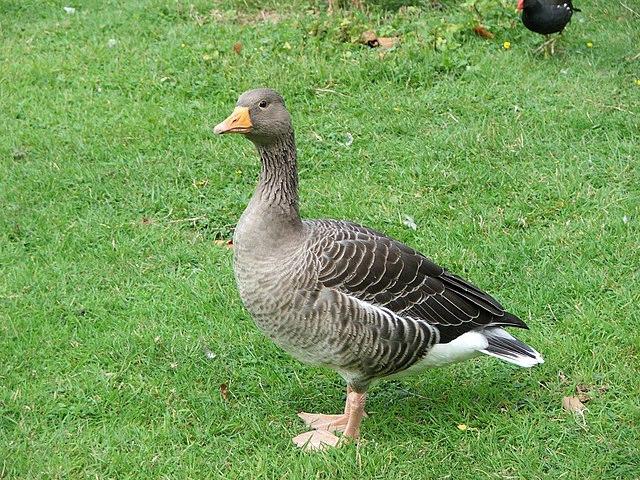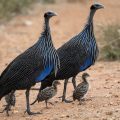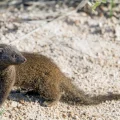The gander goose, also known as the male goose, is a fascinating bird that is often overlooked in favor of its female counterpart, the goose. However, the gander plays an important role in the world of geese and deserves recognition for its unique characteristics and behaviors.
One of the most striking features of the gander is its long, flexible neck. This neck allows the gander to stretch and crane its head to get a better view of its surroundings. In fact, the verb “gander” itself means to look or glance at something, and it is derived from the image of the gander stretching its neck to see more clearly.
The gander’s role in a gaggle, which is a group of geese, is that of a sentinel. It is the gander’s responsibility to keep watch for any potential threats or intruders, using its keen eyesight and alertness to ensure the safety of the group. This protective instinct is especially evident during nesting season when geese are most vulnerable.
While the gander may not receive as much attention as the goose, it is just as important in terms of reproduction. The gander plays a vital role in the mating process, engaging in elaborate courtship displays to attract a mate. These displays often involve honking, head bobbing, and wing flapping, all designed to impress the female geese and establish dominance among other male suitors.
In terms of physical appearance, the gander is typically larger and more robust than the goose. This size difference is not only a result of sexual dimorphism but also serves a practical purpose. The gander’s larger size and strength make it better equipped to defend its territory and protect its family from potential predators.
While the gander may not lay eggs like the goose, it still contributes to the survival of the species through its protective instincts, courtship displays, and overall role in the gaggle. It is a true partner to the goose and should be recognized for its contributions.
The gander goose is an important and fascinating bird that deserves more attention and recognition. Its long, flexible neck, protective instincts, courtship displays, and overall role in the gaggle make it a unique and valuable member of the avian community. So, let us take a gander at the gander and appreciate its significance in the world of geese.
What Does Goose And Gander Mean?
The phrase “what’s good for the goose is good for the gander” is an idiom that means that what is suitable or acceptable for one person or situation should also be suitable or acceptable for another person or situation. The phrase uses the terms “goose” and “gander” to represent two different individuals or entities.
In this idiom, the term “goose” typically represents a female and the term “gander” represents a male. The phrase suggests that if something is considered fair or appropriate for the female (goose), then it should also be considered fair or appropriate for the male (gander). It implies the idea of equal treatment or fairness.
The idiom can be applied to various situations, highlighting the importance of equality and fairness. For example, if a boss allows one employee to take time off for personal reasons, then according to this idiom, the boss should allow all employees to have the same privilege. It emphasizes the notion that rules or standards should be consistent and applied equally to everyone.
“what’s good for the goose is good for the gander” is an idiom that promotes equality and fairness by suggesting that what is suitable or acceptable for one person or situation should also be suitable or acceptable for another person or situation.

Why Is A Goose Called A Gander?
A goose is called a gander primarily because of its distinctive features and behavior. The term “gander” specifically refers to a male goose. The use of this term is rooted in the physical characteristics and behavior of male geese.
1. Differentiating sexes: The term “gander” is used to distinguish between male and female geese. While a female goose is simply referred to as a “goose,” the term “gander” specifically identifies the male counterpart.
2. Pronunciation: The word “gander” itself has a distinct sound and rhythm, which adds to its appeal and uniqueness. It is a concise and efficient way to refer to a male goose without any confusion.
3. Sentinel behavior: Male geese, or ganders, often exhibit sentinel behavior in a gaggle (a group of geese). They play the role of sentinels, keeping a watchful eye on their surroundings and potential threats. The long, flexible neck of a goose allows it to crane its neck and examine its surroundings, similar to how a sentinel would look out for danger.
4. Gooseneck association: The term “gander” is also related to the physical appearance of geese. The long, flexible neck of a goose is reminiscent of the gooseneck, a type of lamp once commonly used in offices. This association may have contributed to the use of “gander” as a term for looking or observing something.
A male goose is called a gander because of its distinct features and behavior. The term helps differentiate between male and female geese and is associated with the sentinel behavior and the physical appearance of geese with their long necks.
What Do They Call A Female Goose?
A female goose is commonly referred to as a dame. This term is used to distinguish the female from the male, which is known as a gander. However, it’s important to note that the term “dame” is not universally used and there are other terms that can be used to describe a female goose as well. For instance, some people may simply refer to a female goose as a “female goose” or a “female gander.” Additionally, in certain contexts or regions, different terms may be used. It is worth mentioning that a young goose is called a gosling, while a group of geese together on the ground is called a gaggle.
What Is Gander Slang For?
Gander, as a slang term, refers to taking a look at or glancing at something or someone. It is often used to express the act of briefly observing or examining someone or something. The term originated in the early 1900s and is believed to have come from the verb “gander,” which means to stretch one’s neck to see. This could be related to the long neck of a male goose, as the verb is commonly associated with the curious action of geese stretching their necks to get a better view. In essence, when someone asks you to “take a gander,” they are requesting that you have a quick look or glance at something or someone.
Conclusion
The phrase “what’s good for the goose is good for the gander” highlights the idea that individuals or situations should be treated equally. The use of the term “gander” in this expression is derived from the behavior of male geese, known as ganders, who play a protective role by craning their necks to look out for potential threats. This behavior is reminiscent of the action of taking a quick glance or look, which is colloquially referred to as taking a gander.
The term “gander” is often used as a synonym for the act of looking or glancing, possibly due to the elongated neck of the male goose. The phrase emphasizes the principle of fairness and equality, suggesting that if one person or situation is allowed certain privileges or rights, then others should be granted the same.
By using this idiom, we can convey the notion that both men and women should be treated equally and given the same opportunities and freedoms. It promotes the idea that what is deemed acceptable or beneficial for one gender should also apply to the other. This concept can be applied in various contexts, such as relationships, work environments, and societal norms.
In essence, the expression “what’s good for the goose is good for the gander” serves as a reminder to treat all individuals fairly and impartially, regardless of gender. It encourages us to embrace equality and ensure that everyone has access to the same rights, benefits, and opportunities.












